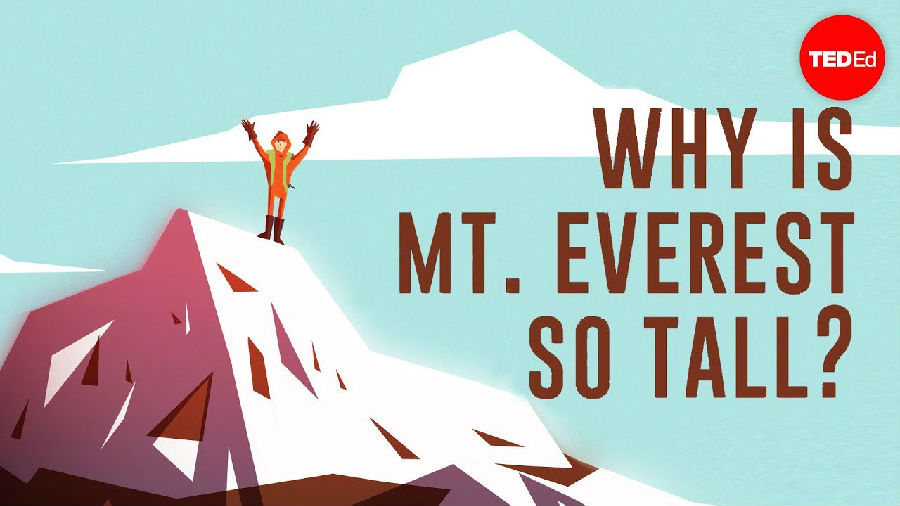(单词翻译:单击)
Every spring, hundreds of adventure-seekers dream of climbing Qomolangma, also known as Mount Everest.
每个春天,成百的冒险者梦想着攀登珠穆朗玛峰,也就是Mount Everest。
At base camp, they hunker down for months waiting for the chance to scale the mountain's lofty, lethal peak.
他们在山脚的大本营蹲守数月,等待登上这高耸、致命山峰的最佳时机。
But why do people risk life and limb to climb Everest?
然而为什么人们会冒着生命危险攀登珠峰呢?
Is it the challenge? The view? The chance to touch the sky?
是因为充满挑战?为了风光?为了有机会触碰蓝天?
For many, the draw is Everest's status as the highest mountain on Earth.
对很多人来说,是珠峰作为世界最高峰的地位吸引着他们。
There's an important distinction to make here.
在这里需要区分一点。
Mauna Kea is actually the tallest from base to summit,
事实上,莫纳科历山就从山脚到顶峰来说是最高的,
but at 8850 meters above sea level, Everest has the highest altitude on the planet.
但仅比海平面高8850米,珠峰则是地球上海拔最高的山峰。
To understand how this towering formation was born,
要想知道其高峰是如何形成的,
we have to peer deep into our planet's crust, where continental plates collide.
我们需要深入地壳去看一看,大陆板块在那里碰撞。
The Earth's surface is like an armadillo's armor.
地球的表面就像是犰狳的盔甲一样。
Pieces of crust constantly move over, under, and around each other.
一块块地壳板块持续移动,相互重叠,四处漂移。
For such huge continental plates, the motion is relatively quick.
对于如此巨大的大陆板块而言,这种运动相对迅速。
They move two to four centimeters per year, about as fast as fingernails grow.
他们每年移动2至4厘米,和指甲生长的速度差不多。
When two plates collide, one pushes into or underneath the other, buckling at the margins,
当两个板块碰撞时,一块会被挤进或挤到另一块下面,在边缘皱缩,
and causing what's known as uplift to accomodate the extra crust.
并为了容纳多出的板块,产生的现象被称为板块的隆升。
That's how Everest came about.
这也是珠峰的来历。
50 million years ago, the Earth's Indian Plate drifted north,
五千万年前,地球印度板块向北漂移,
bumped into the bigger Eurasian Plate, and the crust crumpled, creating huge uplift.
撞击较大的欧亚大陆板块,地壳因此皱缩,产生巨大的隆升。
Mountain Everest lies at the heart of this action, on the edge of the Indian-Eurasian collision zone.
珠穆朗玛峰就位于这一活动发生的中心,也就是印度-亚欧碰撞区的边缘。
But mountains are shaped by forces other than uplift.
但使山峰形态的形成的外力不止隆升。
As the land is pushed up, air masses are forced to rise as well.
随着陆地被抬高,气团同样被迫上升。
Rising air cools, causing any water vapor within it to condense and form rain or snow.
升高的空气温度降低,使其内部的水蒸气冷凝,并形成降雨或降雪。
As that falls, it wears down the landscape, dissolving rocks or breaking them down in a process known as weathering.
降水落下,侵蚀地表,使岩石溶解或降解,也就是风化。

Water moving downhill carries the weathered material and erodes the landscape, carving out deep valleys and jagged peaks.
沿着山坡流下的水卷携被风化的物质,腐蚀地面,雕刻出幽深的山谷和参差的山峰。
This balance between uplift and erosion gives a mountain its shape.
隆升和侵蚀间的平衡为山峦赋予了形态。
But compare the celestial peaks of the Himalayas to the comforting hills of Appalachia.
但比一比喜马拉雅山的入云高峰和阿帕拉齐亚的舒缓山峦。
Clearly, all mountains are not alike.
很明显,山并非都长一个样子。
That's because time comes into the equation, too.
那是因为时间也在其中起着作用。
When continental plates first collide, uplift happens fast.
当大陆板块最初碰撞时,隆升十分迅速。
The peaks grow tall with steep slopes.
山峰一边长高一边形成陡坡。
Over time, however, gravity and water wear them down.
随着时间的流失,重力和水使其被磨平。
Eventually, erosion overtakes uplift, wearing down peaks faster than they're pushed up.
最终,侵蚀的作用反超隆升,磨平山峰的速度超出其被推高的速度。
A third factor shapes mountains: climate.
第三个塑造山峦的因素是气候。
In subzero temperatures, some snowfall doesn't completely melt away, instead slowly compacting until it becomes ice.
当温度在零下时,一些降雪并不完全融化,而是逐渐变得紧密,直至成为冰。
That forms the snowline, which occurs at different heights around the planet depending on climate.
这使雪线得以形成,地球上各处的雪线高度有所不同是依据气候所致的。
At the freezing poles, the snowline is at sea level.
在寒冷的极地,雪线位于海平面。
Near the equator, you have to climb five kilometers before it gets cold enough for ice to form.
在赤道附近,你不得不攀爬五千米才达到冷到足以形成冰的高度。
Gathered ice starts flowing under its own immense weight
聚集起来的冰在因其巨大的质量开始流动,
forming a slow-moving frozen river known as a glacier, which grinds the rocks below.
形成一种缓慢移动的冻流,也就是冰川,冰川打磨其下的岩石。
The steeper the mountains, the faster ice flows, and the quicker it carves the underlying rock.
山越陡峭,冰移动的速度就越快,冰雕磨下面岩石的速度就越快。
Glaciers can erode landscapes swifter than rain and rivers.
冰川能够比降雨和河流更快地侵蚀地表。
Where glaciers cling to mountain peaks, they sand them down so fast, they lop the tops off like giant snowy buzzsaws.
冰川紧附山峰之处,沙土流失得很快,冰川就像一把巨大的冰雪锯子,切断山顶。
So then, how did the icy Mount Everest come to be so tall?
那么,寒冷的珠峰是如何长这么高的呢?
The cataclysmic continental clash from which it arose made it huge to begin with.
灾难性的板块冲撞使其上升,让它在最初十分巨大。
Secondly, the mountain lies near the tropics, so the snowline is high,
其次,这座山位于热带附近,所以雪线较高,
and the glaciers relatively small, barely big enough to widdle it down.
且冰川相对较小,不太可能大到把它冲下来。
The mountain exists in a perfect storm of conditions that maintain its impressive stature.
这座山所在之处的具有的自然条件对于保持其骄人外形而言堪称完美。
But that won't always be the case.
不过事情不总是这样。
We live in a changing world where the continental plates, Earth's climate,
我们处在一个不断变化的世界,大陆板块,地球的气候,
and the planet's erosive power might one day conspire to cut Mount Everest down to size.
以及侵蚀能力也许会在某一刻共同将珠峰削低。
For now, at least, it remains legendary in the minds of hikers, adventurers, and dreamers alike.
至少在现在,它对于登山者、冒险家和梦想家而言仍然是一个传奇。


